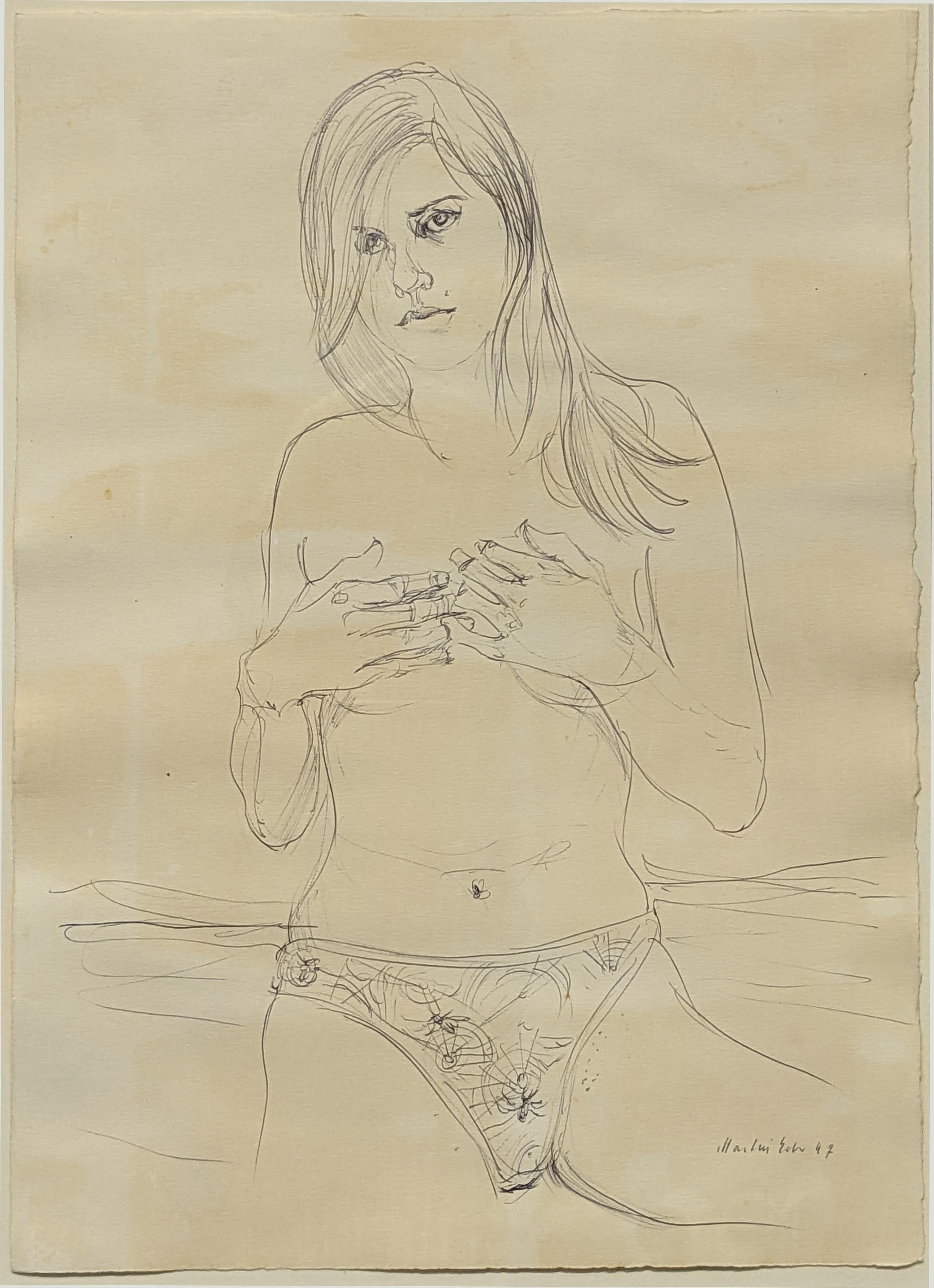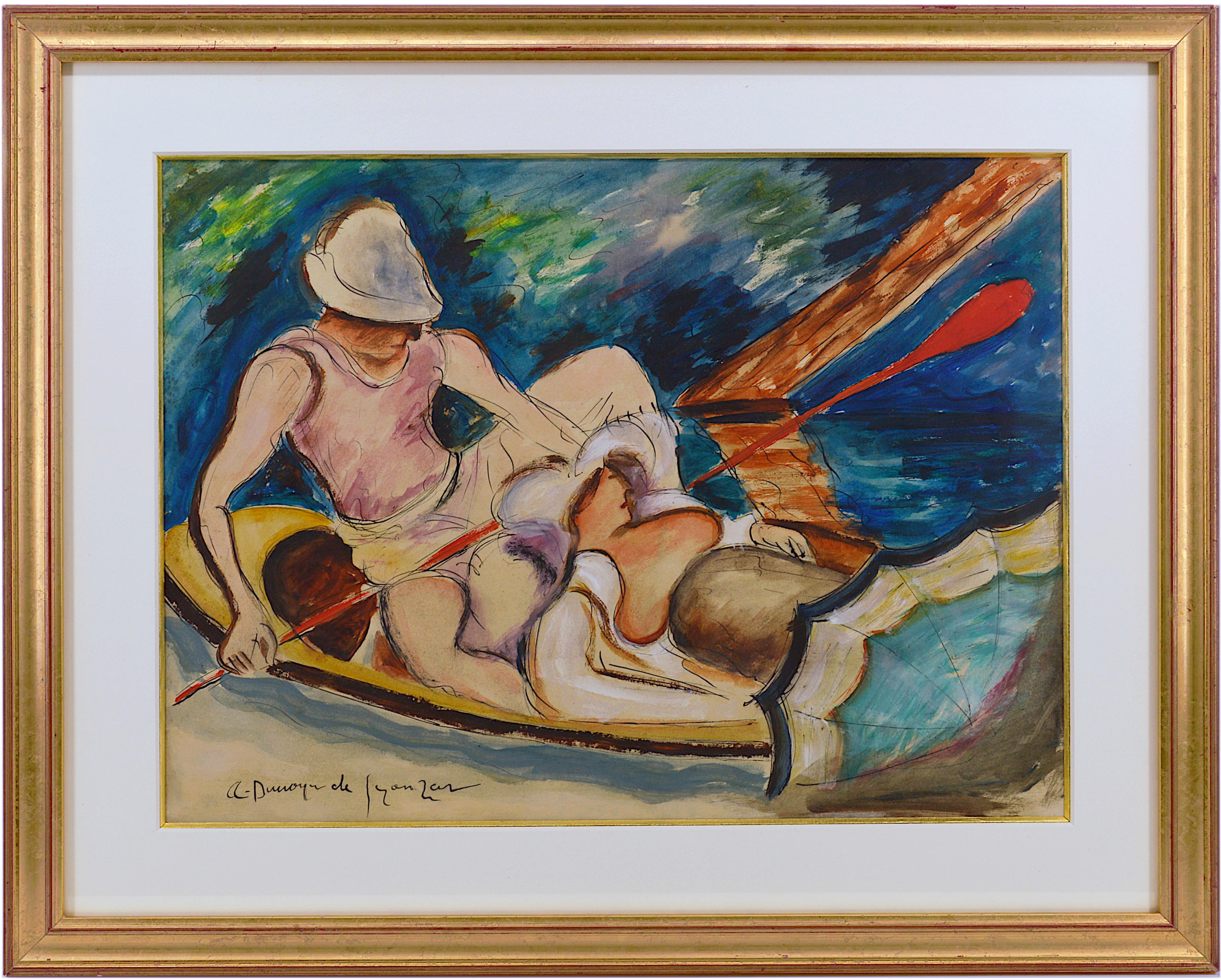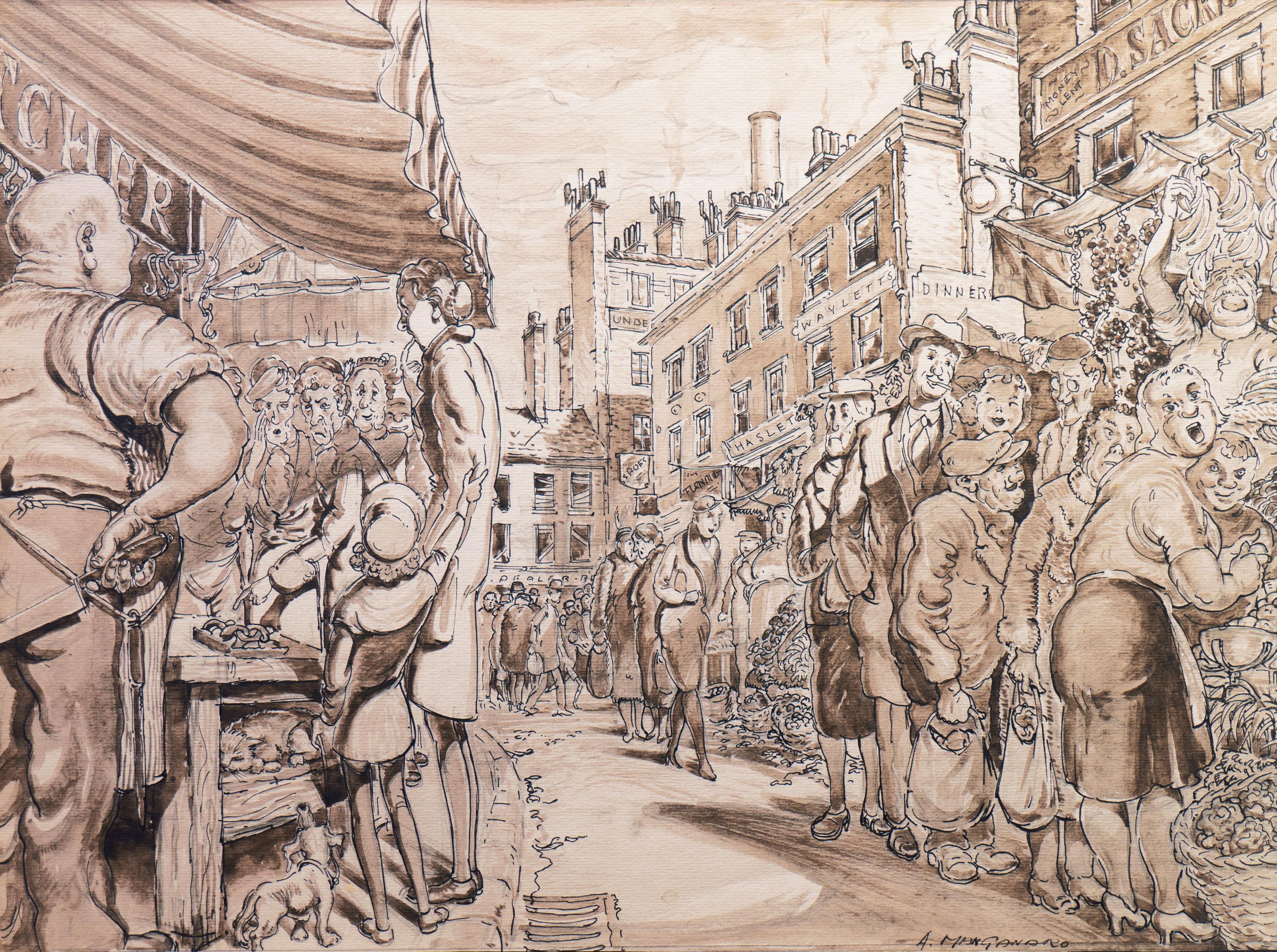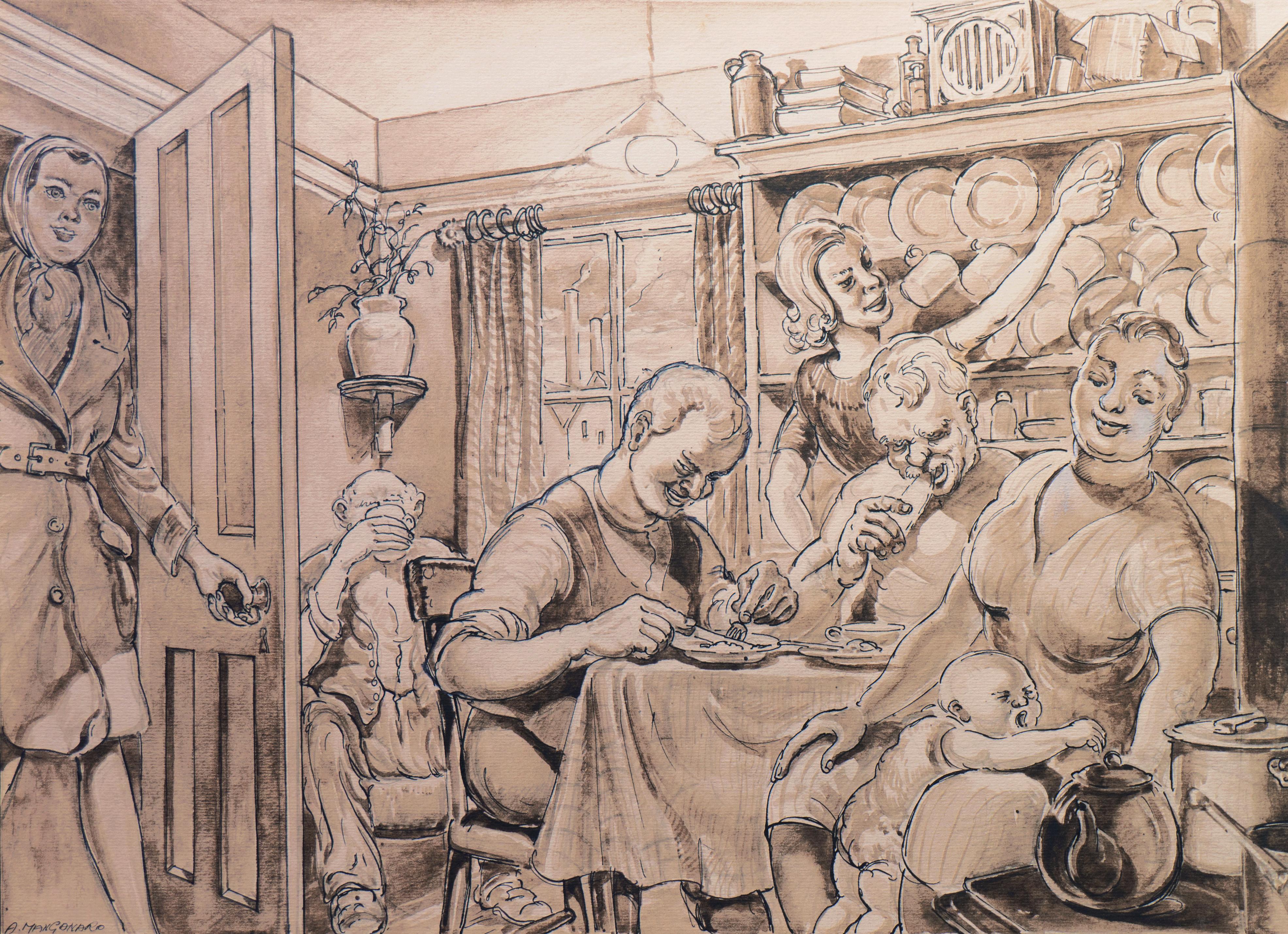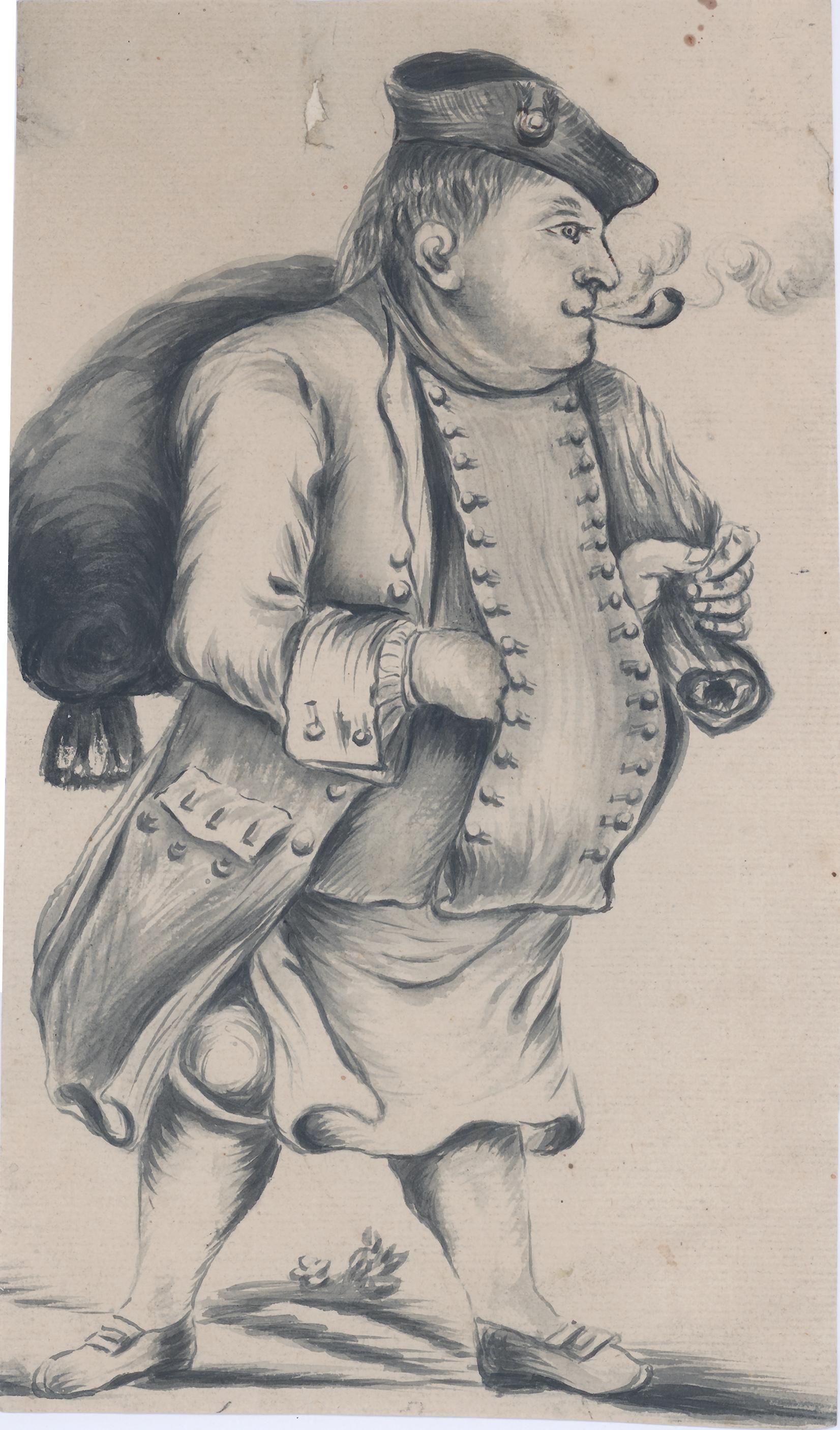Items Similar to William Alfred Pite Design for King`s College Hospital, Denmark Hill London 1913
Want more images or videos?
Request additional images or videos from the seller
1 of 5
William Alfred PiteWilliam Alfred Pite Design for King`s College Hospital, Denmark Hill London 19131913
1913
About the Item
THE ARCHITECT'S ORIGINAL PROPOSAL FOR KING'S COLLEGE HOSPITAL
William Alfred Pite (1860-1949)
King`s College Hospital, Denmark Hill general bird`s-eye view (1913)
Initialled H.M.F., signed and titled by William A. Pite F.R.I.B.A. (1860-1949), lower right, on board support with R.I.B.A. `Exhibition of Contemporary British Architecture` label, and architect`s label both mounted on verso
Watercolour over pencil
46 x 92cm (26.25 x 18 inches)
Pite was a travelling student of the Architectural Association. Pite’s brother Arthur Beresford Pite was also an architect. Pite built All Saints Church Ealing and the Medical School at Aberdeen University. In 1919 Pite took his son and Fairweather (the draughtsman of this drawing) into partnership with him. The present drawing relates to the 1909 new King’s College Hospital. Originally a 120-bed hospital, on a site near Lincoln’s Inn Fields, opened in 1840 and within two years it was overwhelmed, with two patients often forced to share a single bed. Following demographic changes, a decision was taken to move the hospital to the open spaces of Denmark Hill. Following an Act of Parliament in 1904, the foundation stone for Pite’s design was laid in 1909. Pite wrote ‘The whole of its great ward blocks face Ruskin Park, so munificently secured by the Camberwell authorities, and practically open country – a magnificent position which no other London hospital possesses.’ (British Medical Journal 29th July 1905.) This open country is clearly shown in this impressive drawing.
Hubert Moore Faireweather (1881-1950). Born in Esher, in Surrey, he was articled to Arthur Smyth Flower between 1897 and 1899 and then became assistant to William Douglas Caröe and subsequently Walter Henry Brierley. In 1906 he joined Pite, being taken into the partnership in 1919.
- Creator:William Alfred Pite (1860 - 1949)
- Creation Year:1913
- Dimensions:Height: 18.12 in (46 cm)Width: 36.23 in (92 cm)
- Medium:
- Movement & Style:
- Period:
- Condition:
- Gallery Location:London, GB
- Reference Number:1stDibs: LU79532715593
About the Seller
4.8
Gold Seller
These expertly vetted sellers are highly rated and consistently exceed customer expectations.
Established in 2014
1stDibs seller since 2017
282 sales on 1stDibs
Typical response time: <1 hour
- ShippingRetrieving quote...Ships From: London, United Kingdom
- Return PolicyA return for this item may be initiated within 14 days of delivery.
More From This SellerView All
- Bianchini Ferrier Scarf Design 1945 Alsace Lorraine France VE Day World War 2By Bianchi FerrierLocated in London, GBTo see our other World War Two art, scroll down to "More from this Seller" and below it click on "See all from this Seller." Design for Bianchini Ferier, Lyon for a silk scarf 5 Mar...Category
1940s Realist Drawings and Watercolor Paintings
MaterialsPen, Gouache
- Bianchini Ferrier Design for scarf for R.A.F. World War 2 Battle of BritainBy Bianchi FerrierLocated in London, GBTo see our other World War Two art, scroll down to "More from this Seller" and below it click on "See all from this Seller." Design for Bianchini Férier, Lyon for a silk scarf c. 19...Category
1940s Realist Drawings and Watercolor Paintings
MaterialsPen, Gouache
- Edward Bawden Secretary Cat pen and ink Modern British Art drawingBy Edward BawdenLocated in London, GBFrom a series of Bawden Cat illustrations we have listed. To see the others and our other Modern British Art, scroll down to "More from this Seller" a...Category
Late 20th Century Realist Animal Drawings and Watercolors
MaterialsInk, Pen
- Edward Bawden Mum Cat With Nine Lives pen and ink Modern British Art drawingBy Edward BawdenLocated in London, GBFrom a series of Bawden Cat illustrations we have listed. To see the others and our other Modern British Art, scroll down to "More from this Seller" a...Category
Late 20th Century Realist Animal Drawings and Watercolors
MaterialsInk, Pen
- Edward Bawden House Proud Mum Cat pen and ink Modern British Art drawingBy Edward BawdenLocated in London, GBFrom a series of Bawden Cat illustrations we have listed. To see the others and our other Modern British Art, scroll down to "More from this Seller" and below it click on "See all fr...Category
Late 20th Century Realist Animal Drawings and Watercolors
MaterialsInk, Pen
- Edward Bawden Nurse Cat With Nine Lives pen and ink Modern British Art drawingBy Edward BawdenLocated in London, GBFrom a series of Bawden Cat illustrations we have listed. To see the others and our other Modern British Art, scroll down to "More from this Seller" a...Category
Late 20th Century Realist Animal Drawings and Watercolors
MaterialsInk, Pen
You May Also Like
- untitled / ohne TitelBy Martin EderLocated in New York, NYMartin Eder untitled work on paper executed in ballpoint pen with traces of watercolor. Ohne Titel Arbeit auf Papier, ausgeführt in Kugelschreiber mit Spuren von Aquarell. 2007Category
Early 2000s Realist Nude Drawings and Watercolors
MaterialsInk, Watercolor, Pen
- "Boating on the Morin River"By André Dunoyer de SegonzacLocated in Saint Amans des cots, FRPen, ink, watercolor and wash on paper by André Dunoyer de Segonzac, France, 1922-1924. Boating on the Morin River. Measurements : with frame: 52.5x65x2 cm - 20.7x25.6x0.8 inches / without frame: 36.5x45 cm - 14.4x17.7 inches. Signed lower left "A. Dunoyer de Segonzac". Colors may vary slightly depending on your screen. The lighter band at the top and the bottom of the piece, visible in the first picture, is only due to the reflection in the protective glass. It does not exist. In its frame gilt with gold leaf and its protective glass. André Dunoyer de Segonzac was born in Boussy-Saint-Antoine (Essonne) July 7, 1884. After his schooling at high school Henri IV, as early as 1900, he attends classes at the National School of Fine Arts in Paris in free listener where he will befriend Charles Dufresne. In 1903, he enters the private studio of Luc-Olivier Merson. In 1907, he studies with Jean-Paul Laurens and attends the La Palette and Colarossi academies in Montparnasse. He meets Luc-Albert Moreau and Jean-Louis Boussingault with whom he shares a studio. His first drawings are published in 1908 in The Great Review and The Witness. Nearly indifferent to contemporary aesthetic revolutions, Dunoyer de Segonzac undertakes, with Jean-Louis Boussingault and Luc-Albert Moreau, to revive Gustave Courbet's realism by performing still lifes, nudes, landscapes, in a thick paste and masonry . In one of his letters to the painter Maurice Boitel, he wrote in the 1950s: "I have not forgotten the heroic period of the independents - when we were grouped around Paul Signac, the charming and valiant Maximilien Luce - in these barracks where the living and authentic Art was grouped outside the academic formulas - or literary and systematic tendencies - which were to lead to this abstract aesthetic of which the painting dies. " In 1908, he begins exhibiting at the Salon d'Automne and the Salon des Indépendants, with Paul Signac and Maximilien Luce. He befriends Apollinaire, Max Jacob, Raoul Dufy and Vlaminck. From this period, renting a house belonging to Signac, Dunoyer discovers the landscapes of Saint-Tropez, to which he will remain faithful and where he lived until the end of his life. He stays in Saint-Tropez only in the summer season. For the rest, he leads a real nomadic life, in search of the motive especially through the Île-de-France, the Grand Morin valley, Feucherolles, Chennevières-sur-Marne, Guyancourt, etc. "I also worked a lot on the banks of the Seine in Chatou, Bougival, Andrésy, Poissy and Triel that I particularly like, with its beautiful Gothic church that is reflected in the Seine and the high wooded hills that surround him", he will say. In 1910, he knows fashion designer Paul Poiret and meets Max Jacob, Raoul Dufy and Vlaminck. From 1910 to 1914, he travels to Italy, Spain, North Africa, and is interested in sport and dance (drawings of Isadora Duncan's Russian Ballets, 1911, The Boxers1910). From 1914 to 1918, mobilized in the infantry, he makes the war hardly, before being assigned to camouflage. He performs many war drawings, valuable for their artistic and documentary value. From 1919, he appears again in many exhibitions, including major Parisian salons. Nearly indifferent to contemporary aesthetic revolutions, Dunoyer de Segonzac undertakes, with Boussingault and Moreau, to revive Courbet's realism by performing still lifes, nudes, landscapes, in a thick and masonry paste. Enlisted in engraving by Jean Émile Laboureur, he makes nearly 1,600 brass plaques from 1919 to 1970. He was president of the Society of French painters-engravers. In 1921, he meets Paul Valéry, Léon-Paul Fargue and Jean Cocteau. In 1928, he makes a trip to America where he met with great success. In 1930, he becomes friend with Derain. In 1933 he receiveds the Carnegie Foundation of Pittsburgh Award and in 1934 the Venice Biennale. During the Occupation, in November 1941, he takes part in a "study trip" to Germany, organized by Arno Breker, accepting, like other artists of the most renowned, to visit the hotspots of German culture as well as artist workshops. After the war, he is exhibited in the best galleries...Category
1920s Realist Figurative Drawings and Watercolors
MaterialsPaper, Ink, Watercolor, Pen
- 'The Enduring Attractions of the Open Market', Capitalism SatireBy Antonio ManganaroLocated in Santa Cruz, CASigned lower right, 'A. Manganaro' for 'Antonio Manganaro (Italian, 20th Century), and titled lower center, 'The Enduring Attractions of the Open Market'. Matted Dimensions: 16 x 20Category
Mid-20th Century Realist Figurative Drawings and Watercolors
MaterialsGouache, Pen, Graphite, Paper, Ink
- 'The Working Class Enjoying a Meal', Satire of Capitalism, ProletarianBy Antonio ManganaroLocated in Santa Cruz, CASigned lower left, 'A. Manganaro' for 'Antonio Manganaro (Italian, 20th Century), and titled lower center, 'Ability of the Working Classes to Enjoy Meals Under Humble Surroundings'. ...Category
Mid-20th Century Realist Figurative Drawings and Watercolors
MaterialsPaper, Ink, Gouache, Pen, Graphite
- Seaman in petticoat breeches and slops, smoking a pipe, carrying a carpetbag.Located in Middletown, NYEnglish School, 18th century Pen and black ink with gray wash on cream laid paper, 9 1/4 x 5 inches (238 x132 mm). 1/4 inch repaired loss, top center, to the left of the figure’s h...Category
18th Century Realist Portrait Drawings and Watercolors
MaterialsInk, Watercolor, Laid Paper, Pen
- The Prince's RoomBy Willy PoganyLocated in Buffalo, NYBorn in Szeged, Hungary, he became one of the better known and successful illustrators of the Golden Age of Illustration, completing over 100 books. Among them are "A Treasury of Verse for Little Children," "The Rubaiyat of Omar Khayyam," and "The Rime of the Ancient Mariner." He is probably best known for pen and ink drawings of mythology subjects geared towards children. He studied at Budapest Technical University and attended art schools in Munich and Paris before moving to London at age 23. In 1907, he began illustrating children's books and did a series of annual gift books...Category
1940s Realist Figurative Drawings and Watercolors
MaterialsGouache, Graphite, Pen, Watercolor
